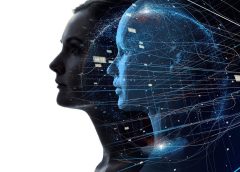
Why Digital Twin Tech Is Coming For Our Bodies
[ad_1]
Soon, we could all have near-live digital representations of our bodies in data, tracking, measuring, and monitoring our movements, our activities, and our key health indicators for health, fitness, and wellness.
It’s already happening.
My smart ring measures body temperature, heart rate, movement, sleep. My smart watch monitors activity, workouts, blood pressure, blood oxygenation. My phone knows how many steps I’ve taken, and if changes in my pace suggest the potential onset of Parkinson’s disease. A small home-based spectrometer can tell you how your blood sugars or cholesterol levels react to different diets. Soon my shoes will know why my Achilles hurt, what’s efficient about my stride, how high I jump, and if my walking, running, or jumping dangerously preferences one side of my body.
Soon we may have a digital twin powered by the data flowing from our wearable tech devices.
“I believe we’re moving very rapidly into this world of personalized wellness, health care, fitness, performance,” Plantiga CEO Quin Sandler told me recently in a TechFirst podcast.
“I think this idea of comparing a human being to another human being is a very old age way of looking at everything. I think what’s going to happen here and where we feel like we’re going is really building the infrastructure to monitor the complexity of how a human being moves, and based on their goals, developing insights and recommendations and interventions — with a possible human in the loop — to really drive better outcomes. Whether, again, that’s performance, or recovery, or injury prevention.”
A Chinese AI passed the country’s national medical licensing exam five years ago, and another in the country of 1.4 billion people with only 3.8 million doctors is already supporting doctors to deliver healthcare faster and cheaper.
That doesn’t mean you or I want to see the virtual AI doctor on our next visit: it’s still early days. It does mean that technology is going to have a greater impact in monitoring and delivering healthcare in the future.
And let’s be honest: it’s much, much needed.
One thing’s clear, there are multiple devices collecting data from our bodies. Plantiga offers a smart sole that fits in your shoe and measures 150 different parameters, Sandler says, about how we walk, jump, turn, twist, and more. Plantiga, which has developed an AI “digital movement coach” named Norman after the CEO’s deceased father (also a co-founder of the company), started in the world of high-performance athletes.
One user: Olympic gold medalist Andre de Grasse, reigning Olympic champion in the 200 meters and recent gold medallist in the 4×100 meters at the 2022 World Championships.
But data on your performance is about more than Olympians. It’s also for seniors.
“Ultimately our goal is to take the power of analyzing human movement to drive better outcomes,” Sandler says. “Whether that is fall prevention in someone my mom’s age, someone that’s dealing with a neurodegenerative disease like Parkinson’s or Alzheimer’s, or an athlete that’s recovering from an ACL or a hip injury. The way that we move tells so much about our health.”
And that health is getting harder to deliver.
Whether it’s high costs in the U.S. or overwhelmed national medical systems in Canada or the UK, getting care to people who need it is harder and harder.
There’s a role for technology here, if we design it well.
Recently I came down with Covid after a flight home from Mexico. I called the health line in BC and was able to tell them my respiration rate and how it had changed from normal, my body temperature, heart rate, and other data that helped a triage nurse confirm that yes, it was covid, no, it was not terribly serious, and yes, I could safely stay home and get healthy.
In a world where nearly 25% of Americans are skipping medical care because they can’t afford it and half the world’s population doesn’t have access to essential health services, how else are we going to deliver at least some level of care? Doctors certainly can’t do it alone: we don’t have enough of them, to start, and the ones we do have are literally overwhelmed by the volume of existing patient health data already.
What we have now is a wealth of data from a fraction of people who wear devices that measure and monitor health indicators. What we don’t have yet is a way in which we can share that data easily in a safe and privacy-compliant way, or a way to broaden the spectrum of people who can afford the devices.
That may come.
Some think we’ll have digital twins of the human body by the end of the decade. Scientists are building the conceptual models, and the wealth of data we’re collecting every day will, conceivably, be able to populate those models.
The challenge, of course, is solving the privacy issues, the access issues, and the basic willingness of people to participate. But our inability to deliver healthcare affordably to billions of people on the planet is probably going to be a key driver in making it happen.
Sandler and Plantiga, of course, are simply focused on one aspect: movement.
“I feel like we’re building and where we want to go in the next five years is being the backbone for that world around the lens of biomechanics and movement, which really appeals to the quarter of the population that deal with musculoskeletal issues,” he says. “That’s where we’re going, almost this like operating system for movement health that can be embedded in shoes. We could monetize that data. We could build predictive analytics around outcomes with different diseases like Parkinson’s, the progressions, the regressions. It’s the data set and what we can do with that, I think, in the next four to five years, that becomes really, really exciting.”
Monetizing the data sounds ominous, although I’m sure that it could be done with permission and while respecting privacy.
But capturing all the data from our devices about our bodies and health, and using it safely and securely to deliver better, quicker, and cheaper healthcare outcomes: that’s an intriguing goal.
Subscribe to TechFirst here; get a transcript of our conversation.
[ad_2]
Source link


